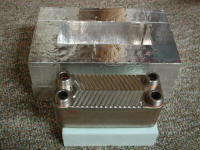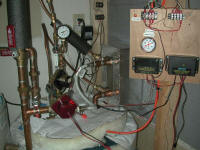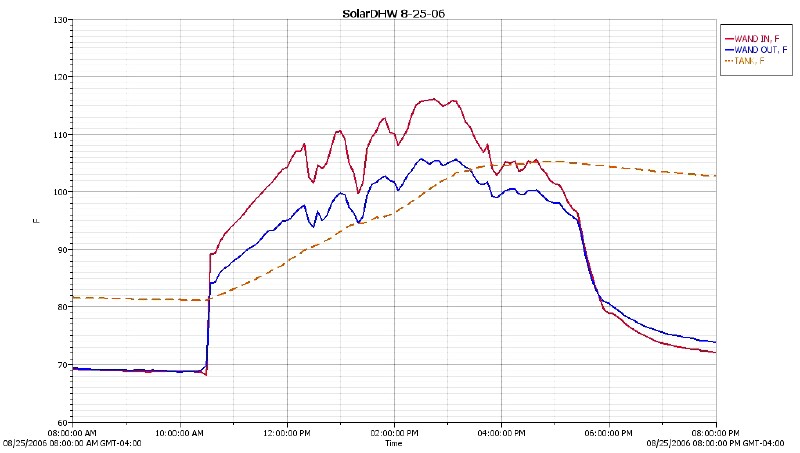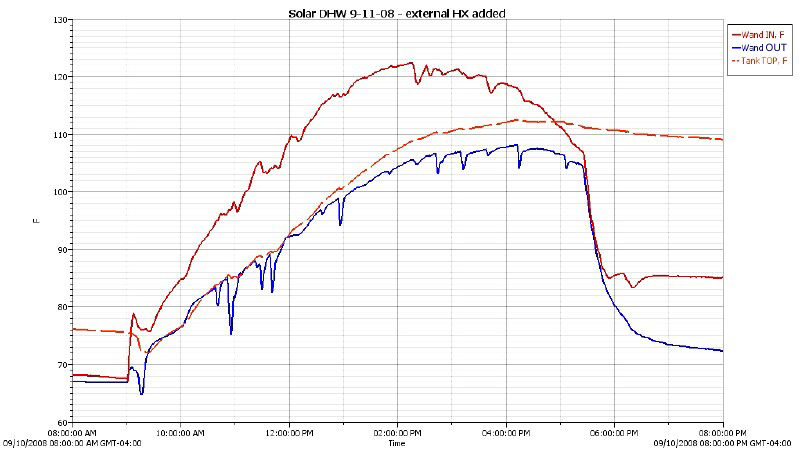|
|
|||
| Product Design | My Artwork | Living Sustainably | |
| Art Engineering | Levitation Kit | Solar Power | Chevy Volt |
| About Me | Blog | Solar Heating | Thermal Windows |
| Contact | Solar Hot Water | Solar Mower | |
|
|
|||
| Product Design | My Artwork | Living Sustainably | |
| Art Engineering | Levitation Kit | Solar Power | Chevy Volt |
| About Me | Blog | Solar Heating | Thermal Windows |
| Contact | Solar Hot Water | Solar Mower | |
home > solar DHW
Installing My Solar
Domestic Hot Water
Heating System
|
Click below to jump to
specific pages
|
|||||||||||||
| HOME |
Receiving parts |
Design tweaks |
Installing staging |
Installing collectors |
Planning plumbing |
Pulling umbilical |
Plumbing tank |
Installing Wand |
Test Results |
Dash board |
Check valve |
Adding HX |
LIVE STATS |
|
|
|
|
|
|
|
|
|
|
|
|
|
|
|
System upgrade: adding a heat exchanger and pump
| August 21,
2008. Time Invested today: 1:45 Add an external heat exchanger and pump |
| After 2 years of watching my dashboard display in the kitchen I have decided that the system could be improved. The maximum temperatures I would see at the top of the storage tank on a clear sunny day would be 90F and often in the low 80's. I decided that the weakest link in the system is the Solar Wand itself since it only has about 2 sq. ft. of surface area to transfer heat. | |
  I
decided to add an external heat exchanger with nearly 3 times the
surface area. I researched heat exchangers and found a really good
deal on eBay ($89.00) for a 20 plate, flat plate heat exchanger. I
decided to add an external heat exchanger with nearly 3 times the
surface area. I researched heat exchangers and found a really good
deal on eBay ($89.00) for a 20 plate, flat plate heat exchanger. This unit has stacked plates that allow the 2 fluids to interleave within. I built an insulating box for it out of 2 inch blue foam board wrapped in aluminum tape. I figured the foam might melt if it got too hot, so the tape should reflect the heat back. Also it just looks kinda NASA tech cool! |
|
 I
also found a good price on a 3 Watt El-Sid pump. This low wattage
pump would not require that I add another solar panel to power it as I
already have a 20 Watt panel running the original 10 Watt pump. The
extra 10 Watts in the original design accounts for my northern latitude
and gives a bit of headroom. Theoretically I should add another 5
Watt panel, but adding a mere 3 Watt load to the 20 Watt panel has not
compromised performance as far as I can tell. In fact performance
of the system is way up! I
also found a good price on a 3 Watt El-Sid pump. This low wattage
pump would not require that I add another solar panel to power it as I
already have a 20 Watt panel running the original 10 Watt pump. The
extra 10 Watts in the original design accounts for my northern latitude
and gives a bit of headroom. Theoretically I should add another 5
Watt panel, but adding a mere 3 Watt load to the 20 Watt panel has not
compromised performance as far as I can tell. In fact performance
of the system is way up! |
|
|
I installed a "T" in the cold water line that feeds down into the bottom of the tank from the outside and put the new (red body) pump there so that it can pull water from the bottom of the tank and pump it through a flexible hose to the heat exchanger. I used a flex hose because the whole addition is really tight and I wanted the option of flexibility. I then plumbed the output from the heat exchanger right into the top of the tank. This particular tank has 2 ports on the sides and 2 on the top. So I had an unused cold inlet at the top that I could use. Strangely this port does not have a dip tube inside, which is actually ideal for my retrofit as I want the hot water to remain at the top. |
|
 I also added a second solar powered differential temperature controller that reads the temperature of the tube just before it enters the new heat exchanger and compares that to a sensor about 14" from the top of the tank. Since I manufacture these controllers I get them for free! Click here to purchase one. |
|
| I am very pleased with the performance of this upgrade. Now I am seeing temperatures over 110F at the end of a good sunny day, often over 116F. This is an average of 20 more degrees. Since our well water is about 65F at this time of year that is a 45-50F improvement for the water entering our propane water heater which is set at 115F. It is running much less often now for sure. | |
| Documentation | |
| I have documented the
increased performance of the new external Heat Exchanger. Below are 2 graphs, one from October 25, 2006 right after I had gotten the system dialed in, and the other from September 11, 2008. The biggest difference is the heat gain as measured at the top of the tank: 2006 went from 82 to 105 = 23F temp rise 2008 went from 68 to 112 = 44F temp rise. A 21F improvement! The difference is that I have gone from 2sq.ft. of heat exchanger surface area to more than 8 sq.ft. Clearly this improves heat transfer efficiency. |
|
 |
|
 |
|
|
If you found the information presented on my web site to be helpful you can send me a donation to show your appreciation for the many hours I have invested in presenting my knowledge and experience. This is NOT tax deductible and will show as a consulting fee on your receipt. |
|